Femtosecond UV Laser Ablation Characteristics of Polymers Used as the Matrix of Astronautic Composite Material
Abstract
:1. Introduction
2. Materials and Methods
2.1. Properties of the Samples
2.2. Laser Ablation and Analysis
3. Results and Discussion
3.1. Transmission and Bandgap Characteristics of Resin Samples
3.2. Determination of Ablation Characteristic for the Two Resins
3.3. Comparations of Ablation Characteristics for the Two Resins and Techniques
4. Conclusions
- (1)
- The transmission spectrum, the absorption coefficient α, and the bandgap of two types of polymer resins were measured and calculated. The bandgap values are 3.1 eV and 2.8 eV for the modified epoxy resin (4211) and the modified cyanate ester resin (BS-4), respectively, which are similar to those of pure epoxy resin reported previously.
- (2)
- The ablation thresholds at 1~300 incident laser shots have been measured for both resins by the diameter-regression technique. The dependence of the ablation threshold on the number of pulses is determined by an incubation effect model. The single-pulse ablation threshold and incubation coefficient for the 4211 resin are 0.42 J/cm2 and 0.73, respectively, while they are 0.45 J/cm2 and 0.74, respectively, for the BS-4 resin.
- (3)
- The depth-regression-technique-based ablation threshold is systematically lower than that of the diameter-regression technique by a factor of 30%~50%. This phenomenon may result from the spallation-dominated ablation dynamics around the threshold fluence.
- (4)
- The energy penetration depth δeff is obtained by the depth-regression technique, and its incubation behavior was modeled similarly to that for the ablation threshold, with an incubation coefficient (σ) included. For the 4211 resin, the σ and δeff for single-pulse excitation are 0.87 and 219 nm, respectively, and they are 0.92 and 183 nm, respectively, for the BS-4 resin. The absorbed energy density Eabs at the ablation threshold for different numbers of pulses is evaluated analytically, yielding a maximum absorbed energy density of 18.4 kJ/cm3 and 23.2 kJ/cm3, respectively, for the 4211 resin and BS-4 resin.
Author Contributions
Funding
Institutional Review Board Statement
Informed Consent Statement
Data Availability Statement
Conflicts of Interest
References
- Rangasamy, G.; Mani, S.; Kolandavelu, S.K.S.; Alsoufi, M.S.; Ibrahim, A.M.M.; Muthusamy, S.; Panchal, H.; Sadasivuni, K.K.; Elsheikh, A.H. An extensive analysis of mechanical, thermal and physical properties of jute fiber composites with different fiber orientations. Case Stud. Therm. Eng. 2021, 28, 101612. [Google Scholar] [CrossRef]
- Raj, M.K.A.; Muthusamy, S.; Panchal, H.; Ibrahim, A.M.M.; Alsoufi, M.S.; Elsheikh, A.H. Investigation of mechanical properties of dual-fiber reinforcement in polymer composite. J. Mater. Res. Technol. 2022, 18, 3908–3915. [Google Scholar] [CrossRef]
- Lu, M.; Zhang, M.; Zhang, J.; Zhang, K.; Zheng, L.; Wei, Y.; Liu, Z.; Rou, L. Picosecond laser ablation characteristics of satellite-used carbon fiber reinforced composites. In Proceedings of the AOPC 2021, Beijing, China, 24 July 2021; SPIE: Bellingham, WA, USA, 2021; Volume 120600Q. [Google Scholar]
- Jiang, H.; Ma, C.; Li, M.; Cao, Z. Femtosecond Laser Drilling of Cylindrical Holes for Carbon Fiber-Reinforced Polymer (CFRP) Composites. Molecules 2021, 26, 2953. [Google Scholar] [CrossRef] [PubMed]
- Lu, M.Y.; Zhang, M.; Zhang, K.H.; Zhang, J.; Wei, Y.; Gao, Y. Threshold properties of high modulus carbon fiber reinforced plastic composite with picosecond laser processing. Acta Mater. Compos. Sin. 2021, 38, 3601–3609. (In Chinese) [Google Scholar]
- Quintero, F.; Riveiro, A.; Lusquiños, F.; Comesaña, R.; Pou, J. Feasibility Study on Laser Cutting of Phenolic Resin Boards. Phys. Procedia 2011, 12, 578–583. [Google Scholar] [CrossRef]
- Correa, D.S.; Almeida, J.M.P.; Almeida, G.F.B.; Cardoso, M.R.; De Boni, L.; Mendonça, C.R. Ultrafast Laser Pulses for Structuring Materials at Micro/Nano Scale: From Waveguides to Superhydrophobic Surfaces. Photonics 2017, 4, 8. [Google Scholar] [CrossRef]
- Cheng, J.; Liu, C.-S.; Shang, S.; Liu, D.; Perrie, W.; Dearden, G.; Watkins, K. A review of ultrafast laser materials micromachining. Opt. Laser Technol. 2013, 46, 88–102. [Google Scholar] [CrossRef]
- Watanabe, W.; Li, Y.; Itoh, K. INVITED Ultrafast laser micro-processing of transparent material. Opt. Laser Technol. 2016, 78, 52–61. [Google Scholar] [CrossRef]
- Zhang, J.B.; Zhang, K.H.; Fan, H.T.; Lu, M.Y.; Gao, Z.; Zhang, X.H. Progress in laser processing of fiber composite materials and prospects for aerospace applications. Acta Aeronaut. Astronaut. Sin. 2022, 43, 025735. (In Chinese) [Google Scholar]
- Oliveira, V.; Sharma, S.; de Moura, M.; Moreira, R.; Vilar, R. Surface treatment of CFRP composites using femtosecond laser radiation. Opt. Lasers Eng. 2017, 94, 37–43. [Google Scholar] [CrossRef]
- Oliveira, V.; Moreira, R.D.F.; Moura, M.D.E.; Vilar, R. Surface patterning of CFRP composites using femtosecond laser interferometry. Appl. Phys. A 2018, 124, 231. [Google Scholar] [CrossRef]
- Wen, P.; Zhang, L.; Zhong, X.; Bao, J. Study on properties of 4211 epoxy resin system. J. Aeronaut. Mater. 2016, 36, 51–55. [Google Scholar]
- Liu, J.M. Simple technique for measurements of pulsed Gaussian-beam spot sizes. Opt. Lett. 1982, 7, 196–198. [Google Scholar] [CrossRef] [PubMed]
- Mannion, P.T.; Magee, J.; Coyne, E.; Glynn, T.J. The effect of damage accumulation behavior on ablation thresholds and damage morphology in ultrafast laser micro-machining of common metals in air. Appl. Surf. Sci. 2004, 233, 275–287. [Google Scholar] [CrossRef]
- Farag, A.M. Optical absorption of sodium copper chlorophyllin thin films in UV-Vis-NIP region. Spectrochim. Acta Part A 2006, 65, 667–672. [Google Scholar] [CrossRef]
- Durmus, H.; Safak, H.; Akbas, H.Z.; Ahmetli, G. Optical properties of modified epoxy resin with various oxime derivatives in the UV-VIS spectral region. J. Appl. Polym. Sci. 2011, 120, 1490–1495. [Google Scholar] [CrossRef]
- Gaudiuso, C.; Terekhin, P.N.; Volpe, A.; Nolte, S.; Rethfeld, B.; Ancona, A. Laser ablation of silicon with THz bursts of femtosecond pulses. Sci. Rep. 2021, 11, 13321. [Google Scholar] [CrossRef]
- Furmanski, J.; Rubenchik, A.M.; Shirk, M.D.; Stuart, B.C. Deterministic processing of alumina with ultrashort laser pulses. J. Appl. Phys. 2007, 102, 073112. [Google Scholar] [CrossRef]
- Rajeev, P.P.; Gertsvolf, M.; Corkum, P.B.; Rayner, D.M. Field Dependent Avalanche Ionization Rates in Dielectrics. Phys. Rev. Lett. 2009, 102, 083001. [Google Scholar] [CrossRef]
- Zhang, K.; Jiang, L.; Li, X.; Shi, X.; Yu, D.; Qu, L.; Lu, Y. Femtosecond laser pulse-train induced breakdown in fused silica: The role of seed electrons. J. Phys. D Appl. Phys. 2014, 47, 435105. [Google Scholar] [CrossRef]
- Jiang, L.; Tsai, H. Energy transport and material removal in wide bandgap materials by a femtosecond laser pulse. Int. J. Heat Mass Transf. 2005, 48, 487–499. [Google Scholar] [CrossRef]
- Zhang, K.; Zhang, J.; Jiang, L.; Li, X.; Liu, Y.; Li, B.; Lu, Y. Ablation enhancement of metal in ultrashort double-pulse experiments. Appl. Phys. Lett. 2018, 112, 261906. [Google Scholar] [CrossRef]
- Beinhorn, F.; Ihlemann, J.; Luther, K.; Troe, J. Plasma effects in picosecond-femtosecond UV laser ablation of polymers. Appl. Phys. A 2004, 79, 869–873. [Google Scholar] [CrossRef]
- Grehn, M.; Seuthe, T.; Hofner, M.; Griga, N.; Theiss, C.; Mermillod-Blondin, A.; Eberstein, M.; Eichler, H.; Bonse, J. Femtosecond-laser induced ablation of silicate glasses and the intrinsic dissociation energy. Opt. Mater. Express 2014, 4, 689. [Google Scholar] [CrossRef]
- Rosenfeld, A.; Lorenz, M.; Stoian, R.; Ashkenasi, D. Ultrashort-laser-pulse damage threshold of transparent materials and the role of incubation. Appl. Phys. A 1999, 69, S373–S376. [Google Scholar] [CrossRef]
- Redka, D.; Gadelmeier, C.; Winter, J.; Spellauge, M.; Eulenkamp, C.; Calta, P.; Glatzel, U.; Minár, J.; Huber, H. Sub-picosecond single-pulse laser ablation of the CrMnFeCoNi high entropy alloy and comparison to stainless steel AISI 304. Appl. Surf. Sci. 2021, 544, 148839. [Google Scholar] [CrossRef]
- Cottrell, T.L. The Strengths of Chemical Bonds, 2nd ed.; Butterworths: London, UK, 1958. [Google Scholar]
- De Darwent, B. National Standard Reference Data Series No. 31; National Bureau of Standards: Washington, DC, USA, 1970. [Google Scholar]
- Benson, S.W. III—Bond energies. J. Chem. Educ. 1965, 42, 502. [Google Scholar] [CrossRef]
- Keldysh, L.V. Ionization in the field of a strong electromagnetic wave. J. Exp. Theor. Phys. 1965, 20, 1307–1314. [Google Scholar]
- Ledesma, R.; Palmieri, F.; Connell, J.; Yost, W.; Fitz-Gerald, J. Surface characterization of carbon fiber reinforced polymers by picosecond laser induced breakdown spectroscopy. Spectrochim. Acta Part B At. Spectrosc. 2018, 140, 5–12. [Google Scholar] [CrossRef]
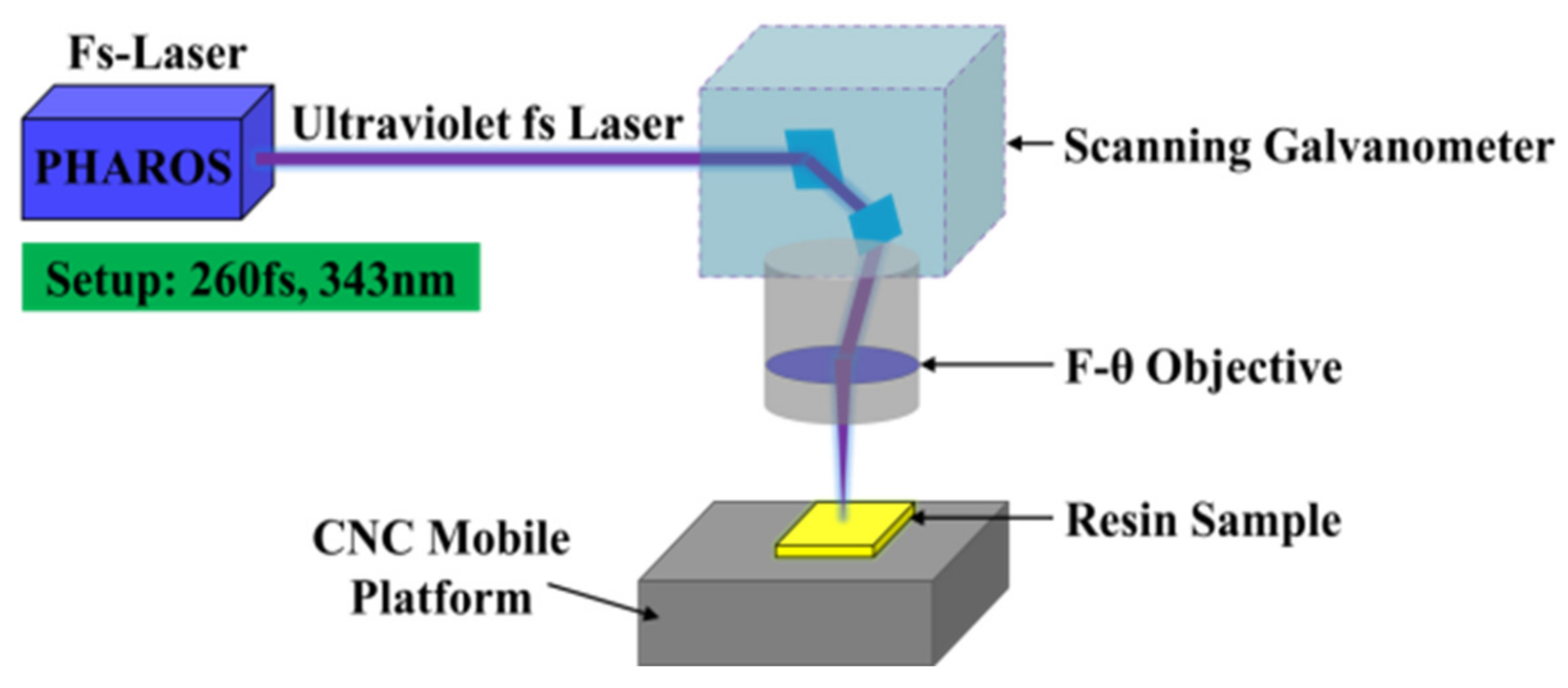
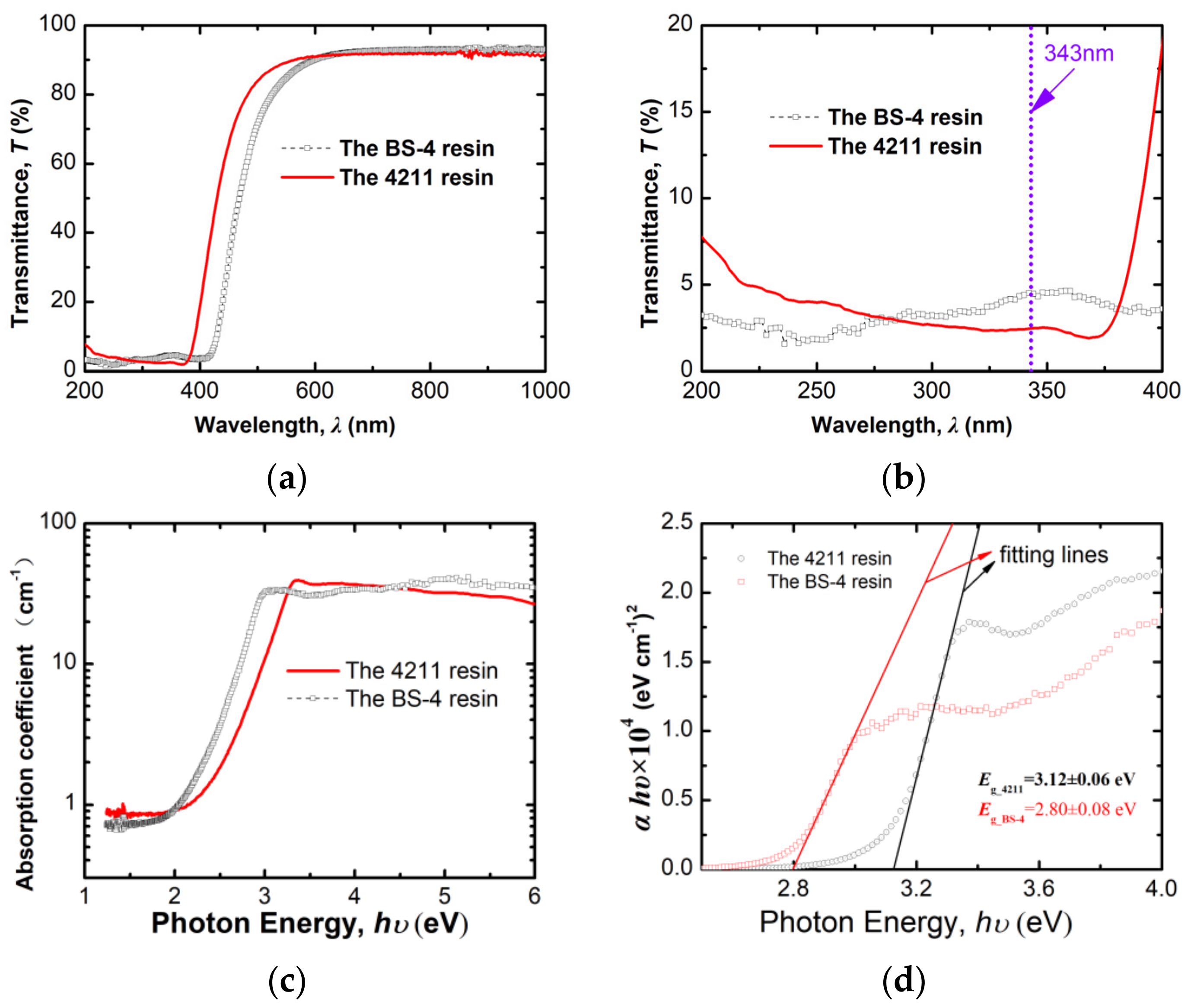
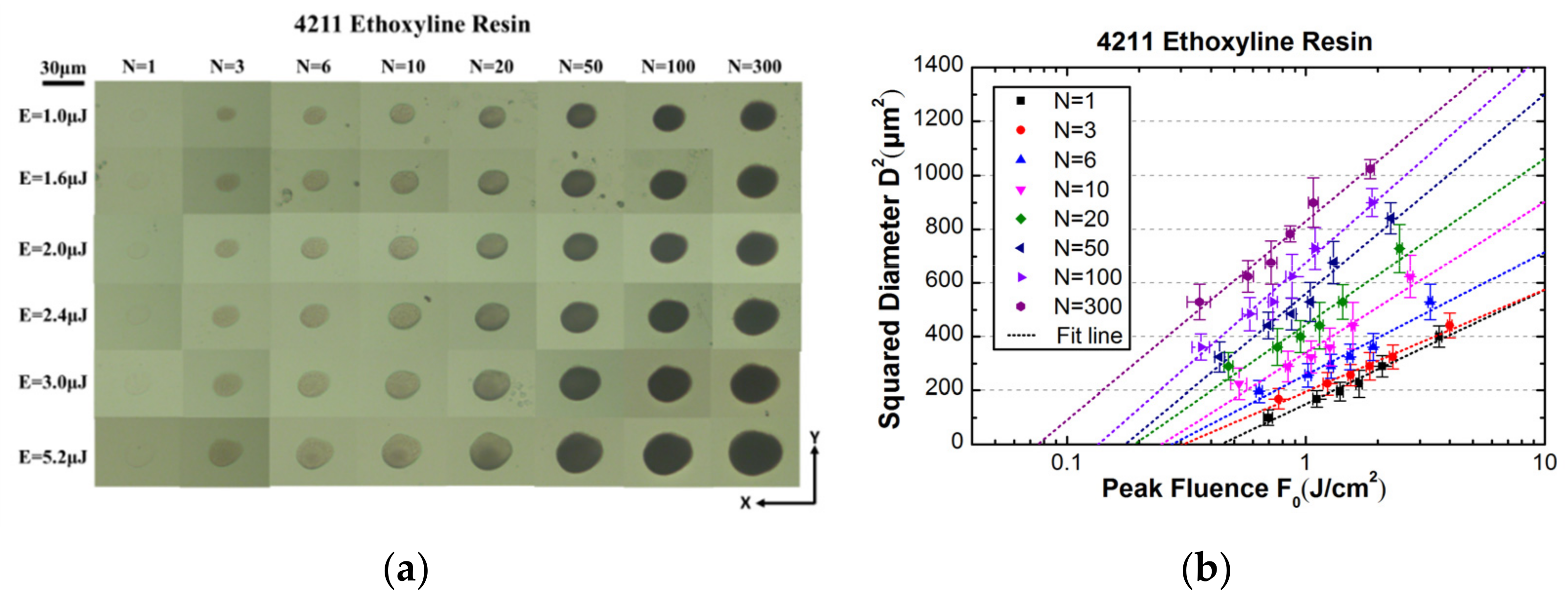
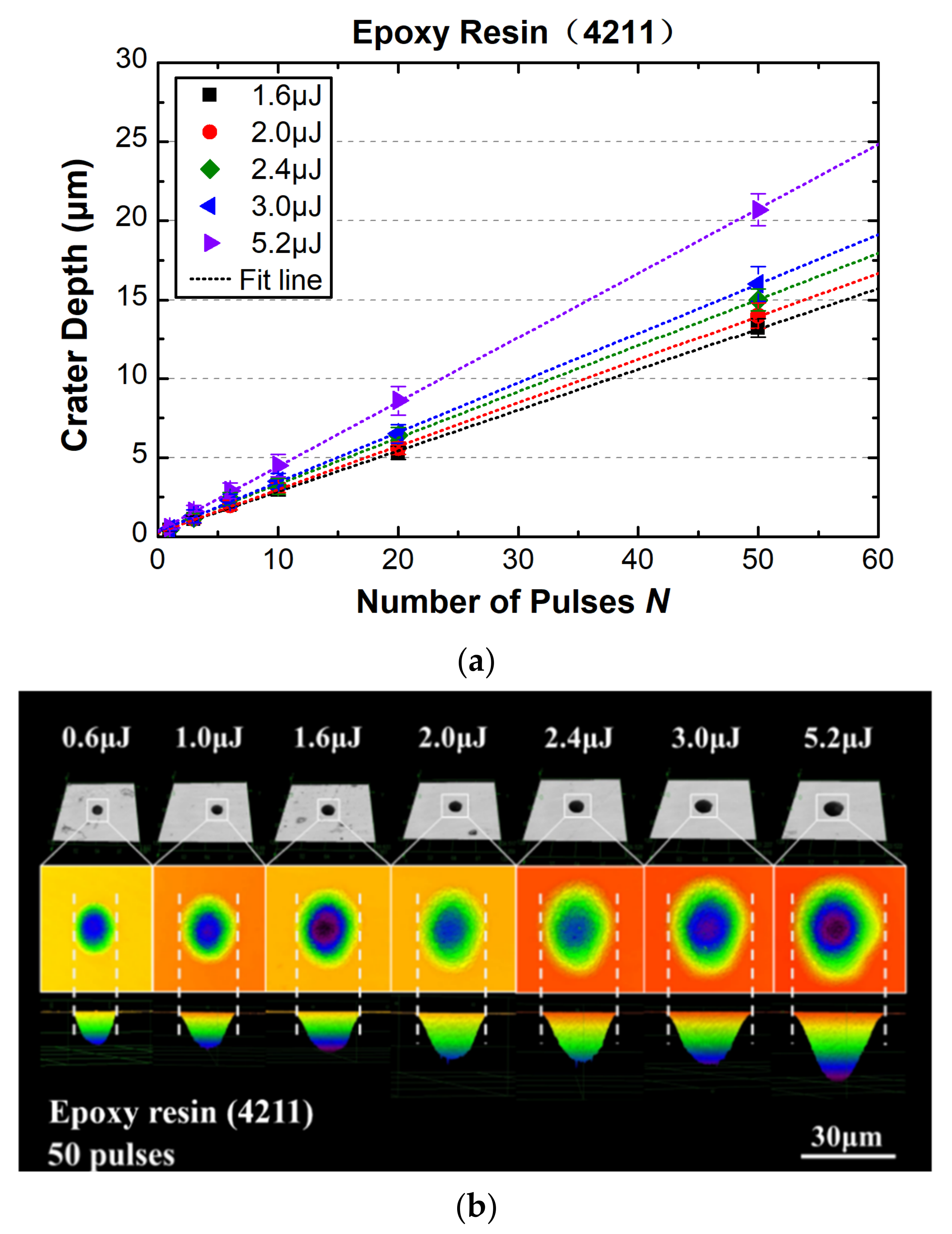

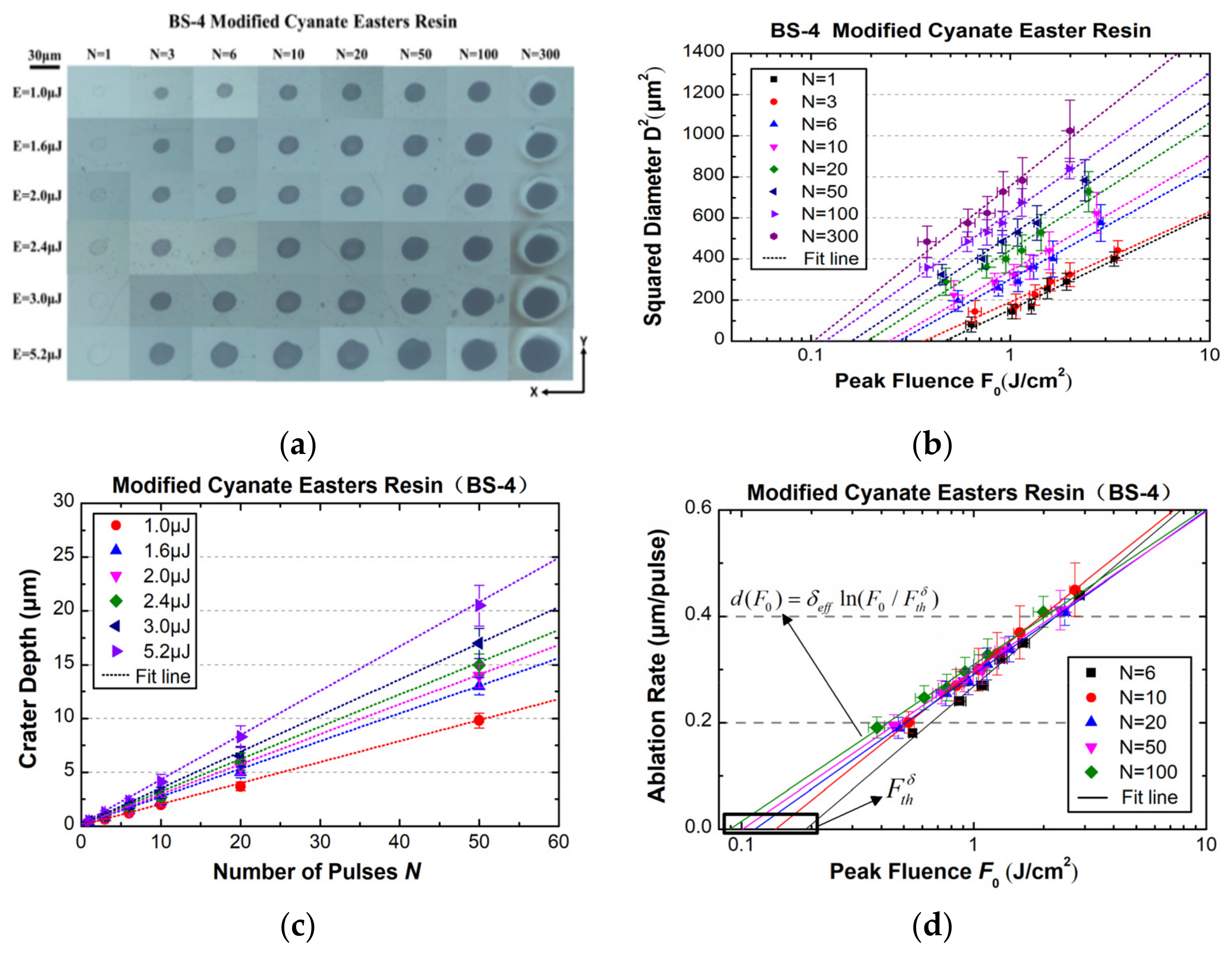
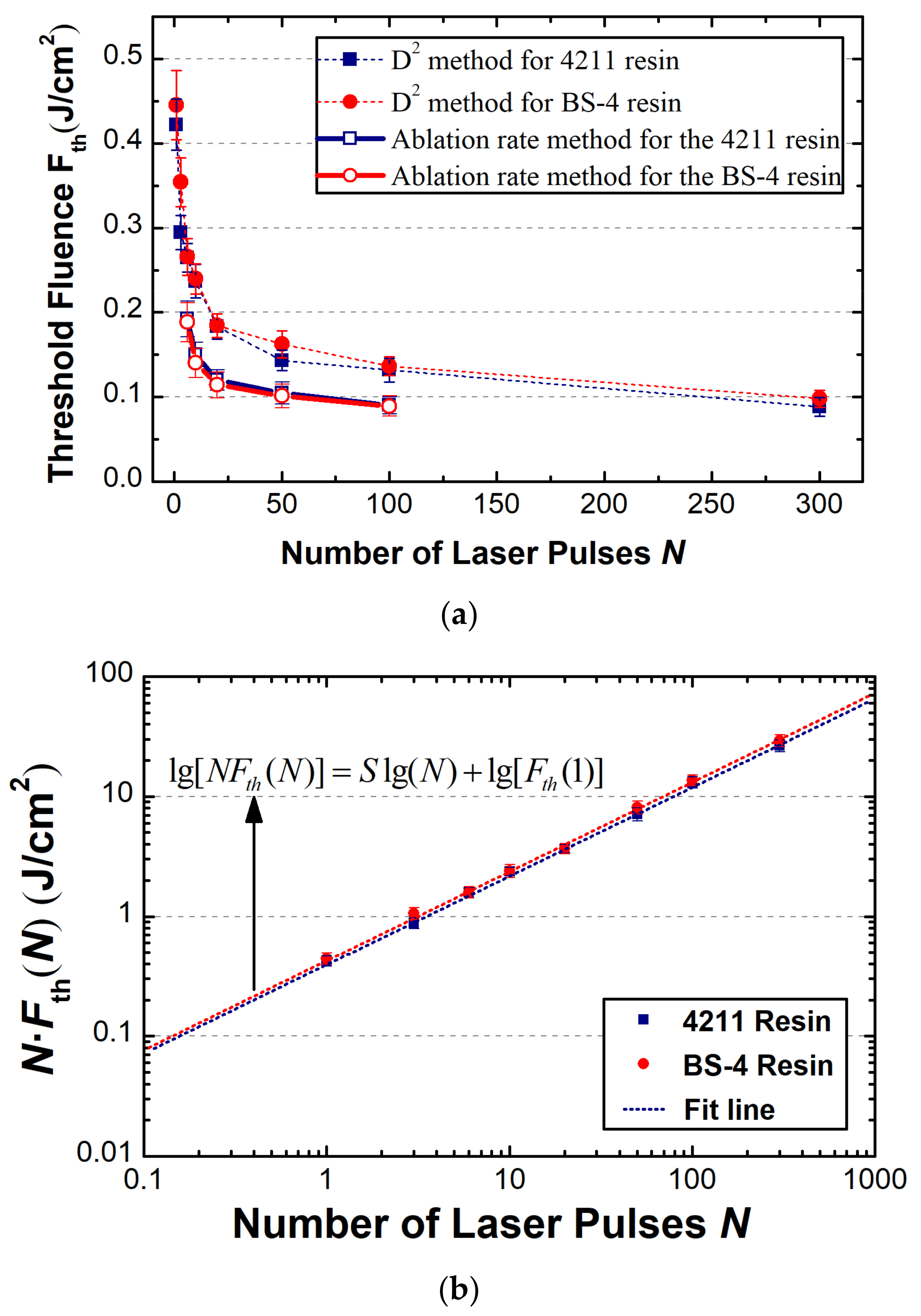
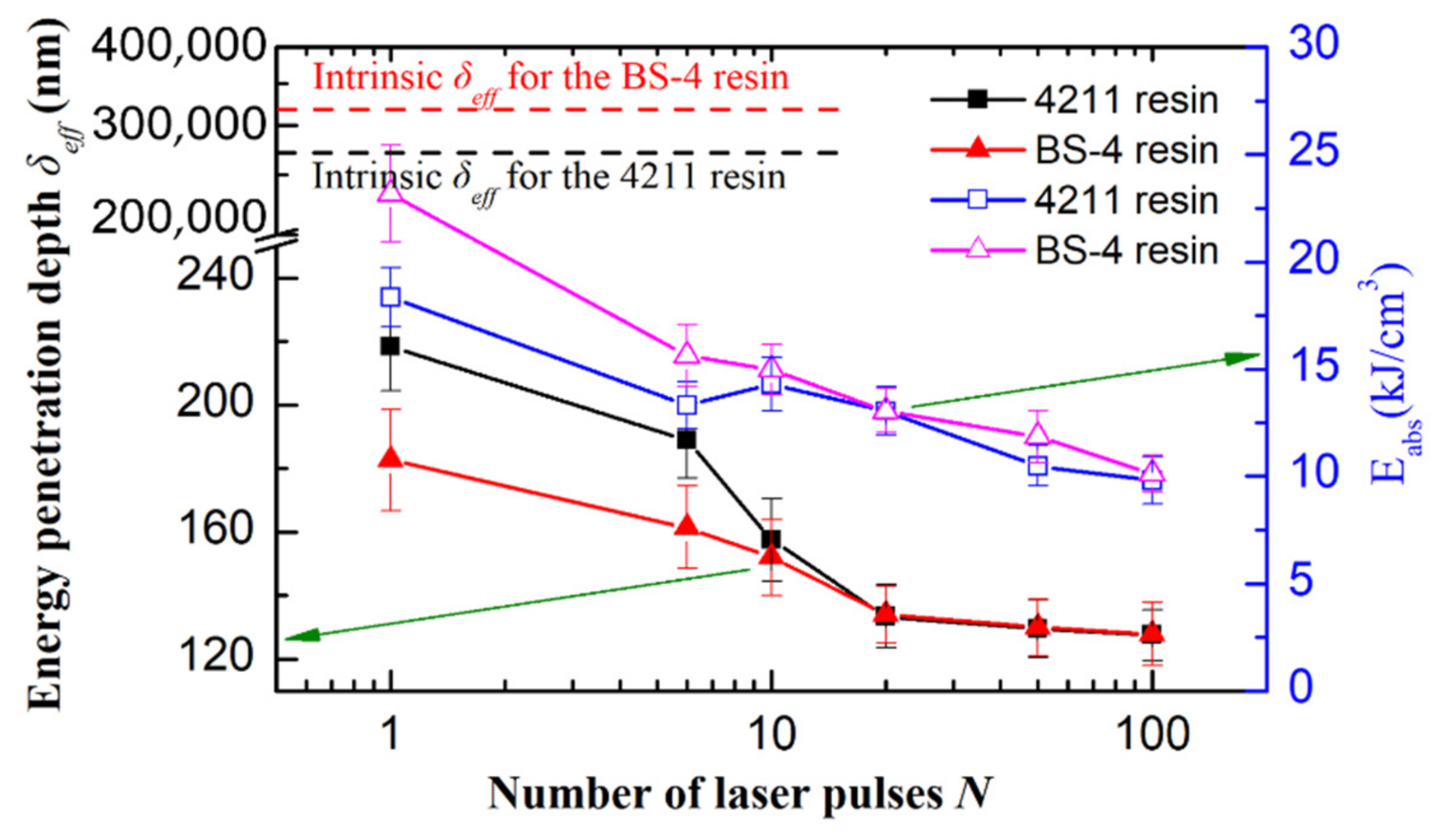
| Number of Shot | Spot Diameter 2ω0 (μm) | Threshold Fluence Fth (J/cm2) |
|---|---|---|
| N = 1 | 19.16 ± 0.36 | 0.42 ± 0.03 |
| N = 3 | 18.17 ± 0.46 | 0.29 ± 0.02 |
| N = 6 | 19.95 ± 0.41 | 0.27 ± 0.02 |
| N = 10 | 22.10 ± 0.54 | 0.24 ± 0.02 |
| N = 20 | 23.18 ± 0.77 | 0.18 ± 0.02 |
| N = 50 | 24.22 ± 0.72 | 0.14 ± 0.01 |
| N = 100 | 26.50 ± 0.86 | 0.13 ± 0.01 |
| N = 300 | 26.69 ± 0.98 | 0.09 ± 0.01 |
| Number of Shot | δeff (nm) | Fδth (J/cm2) |
|---|---|---|
| N = 6 | 189 ± 12 | 0.18 ± 0.03 |
| N = 10 | 157 ± 13 | 0.14 ± 0.02 |
| N = 20 | 134 ± 10 | 0.11 ± 0.02 |
| N = 50 | 129 ± 9 | 0.10 ± 0.01 |
| N = 100 | 128 ± 8 | 0.09 ± 0.01 |
| Number of Shot | δeff (nm) | Fδth (J/cm2) |
|---|---|---|
| N = 6 | 161 ± 13 | 0.18 ± 0.04 |
| N = 10 | 152 ± 12 | 0.13 ± 0.03 |
| N = 20 | 134 ± 9 | 0.11 ± 0.02 |
| N = 50 | 130 ± 9 | 0.10 ± 0.02 |
| N = 100 | 128 ± 10 | 0.09 ± 0.01 |
Publisher’s Note: MDPI stays neutral with regard to jurisdictional claims in published maps and institutional affiliations. |
© 2022 by the authors. Licensee MDPI, Basel, Switzerland. This article is an open access article distributed under the terms and conditions of the Creative Commons Attribution (CC BY) license (https://creativecommons.org/licenses/by/4.0/).
Share and Cite
Lu, M.; Zhang, M.; Zhang, K.; Meng, Q.; Zhang, X. Femtosecond UV Laser Ablation Characteristics of Polymers Used as the Matrix of Astronautic Composite Material. Materials 2022, 15, 6771. https://doi.org/10.3390/ma15196771
Lu M, Zhang M, Zhang K, Meng Q, Zhang X. Femtosecond UV Laser Ablation Characteristics of Polymers Used as the Matrix of Astronautic Composite Material. Materials. 2022; 15(19):6771. https://doi.org/10.3390/ma15196771
Chicago/Turabian StyleLu, Mingyu, Ming Zhang, Kaihu Zhang, Qinggeng Meng, and Xueqiang Zhang. 2022. "Femtosecond UV Laser Ablation Characteristics of Polymers Used as the Matrix of Astronautic Composite Material" Materials 15, no. 19: 6771. https://doi.org/10.3390/ma15196771




